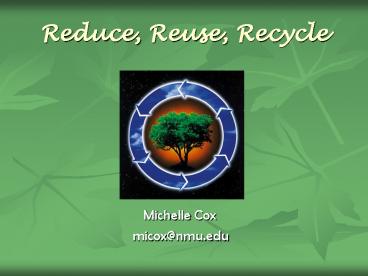Reduce, Reuse, Recycle PowerPoint PPT Presentation
1 / 15
Title: Reduce, Reuse, Recycle
1
Reduce, Reuse, Recycle
- Michelle Cox
- micox_at_nmu.edu
2
All about taking care of Earth
- Help save our natural resources!
- Our natural resources are the things that we
take from the Earth to make all of the things
that we need. When those things get worn out we
throw them out, and they become garbage. - Did you know that we make 250 million tons of
garbage each year! That's a lot of garbage! - People are helping to save our resources by
practicing the 3 R's reduce, reuse and recycle.
You can help, too. - This information can be found at
http//members.aol.com/kidz4peace/dinopals/3r.htm
3
The 3 Rs
- REDUCE
- You can help by PRECYCLING. 1/3 of all garbage is
packaging. - Buy things that are in packages that can be
recycled or are made of recycled materials. - When you buy something small, say no thanks to a
bag. - REUSE
- Many things can be reused before you throw them
out. - Use coffee cans and cottage cheese containers for
storage - Use backs of paper or backs of used envelopes for
jotting notes - Put leftovers in resealable containers instead of
using wraps and foil - Use old clothes as rags for cleaning instead of
paper towels - Have a garage sale or donate clothes, books or
toys that you don't use anymore - RECYCLE
- Each year we use
- 25 billion plastic containers
- 30 billion bottles jars
- 65 billion aluminum cans
- 100 billion pounds of paper
4
Landfill
- What is a landfill?
- A landfill is place where our garbage is taken
and buried between layers of dirt. - How does a landfill work?
- The solid waste is compacted in layers. Each
layer is covered with a layer of dirt. - Paper takes up as much as 50 of all landfill
space.
5
Reduce Waste
- Buy remanufactured or used items
- Buy items in bulk rather than multiple, smaller
packages to decrease the amount of packaging
waste created - Maintain and repair durable items
- Reuse bags, containers, and other similar items
- Borrow, rent, or share items that are used
infrequently - Donate items instead of throwing them out
- Leave grass clippings on the lawn or use them for
backyard composting - Rake fallen leaves for composting rather than
bagging them and throwing them away
6
Composting
- What is composting?
- Composting is when you combine all organic matter
to decay. When this mixture decays, it has
nutrients that can be used to fertilize. - How to compost?
- http//aggie-horticulture.tamu.edu/sustainable/sli
desets/kidscompost/cover.html
7
Reuse
- Have a yard sale with your family or friends.
- Use cloth napkins instead of paper napkins
- Make a cloth lunchbox, or use a store bought one
to replace paper bags.
- Store leftovers in reusable containers instead of
wrap or bags - Shop carrying cloth bags instead of paper or
plastic - Make your own Paper!
- Use old rags to clean your room or paint with
- Use Styrofoam, cans, boxes and other containers
to make things, like crafts. - The next time something is broken try to repair
it instead of replacing it - The next time something is broken try to repair
it instead of replacing it
8
Recycling
- What is recycling?
- Recycling is to reuse or reprocess materials.
- What materials can you recycle?
- Most materials can either be recycled, reused, or
composted. Contact your city recycle center to
find out what your community recycles. - How do you recycle?
- Check the hours for your local recycle center, or
use the curbside system most cities have set-up.
Make sure to separate your recyclables into
separate recycle bins! Also, look for blue bins
at local businesses, parks, etc. for paper and
aluminum can recycling.
9
Recycle Paper!
- By recycling 1 ton of paper, we save
- 17 trees
- 7,000 gallons of water
- 380 gallons of oil
- 3 cubic yards of landfill space
- Enough energy to heat an average home for 6 mo.
10
Recycle Bottles and Cans!
- Manufacturers can make one extra-large T-shirt
our of only five recycled plastic soda bottles - Recycling aluminum cans saves 95 of the energy
required to make aluminum cans from scratch - The amount of aluminum recycled in 1995 could
have built 14 aircraft carriers
11
Recycling Facts
12
Recycling in Action
- Learn about and participate in a community
recycling program. Know the collection schedule
or drop-off location as well as which items are
acceptable. - Empty all fluids and remove all lids from bottles
and cans when recycling and do not contaminate
recycling containers with trash.
- Participate and encourage your classmates to
recycle in the containers provided in your
school. - Make an effort to find recycling opportunities.
- Use recyclable products and encourage others to
do the same.
13
(No Transcript)
14
Check Out these Useful Worksheets
- Follow that Bottle
- Energy Story
- Trash Town
- Energy Expedition
15
- Most of the information and resources for this
presentation was acquired from the United States
Environmental Protection Agency at
http//www.epa.gov/epaoswer/osw/kids/quest/index.h
tm

